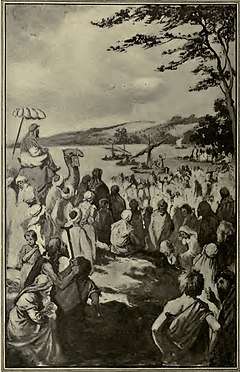Matthew 4:16
Matthew 4:16 is the sixteenth verse of the fourth chapter of the Gospel of Matthew in the New Testament. In the previous verses Jesus returned to Galilee after hearing of the arrest of John the Baptist and then left Nazareth for Capernaum. This verse contains the second half of a quote from the Book of Isaiah, implying that these movements were preordained by scripture.
| Matthew 4:16 | |
|---|---|
← 4:15 4:17 → | |
 "A company had gathered to hear Jesus, - an eager, expectant throng." Christ's Object Lessons by Ellen Gould Harmon White, page 32 | |
| Book | Gospel of Matthew |
| Christian Bible part | New Testament |
Content
The original Koine Greek, according to Westcott and Hort, reads:
- ο λαος ο καθημενος εν σκοτια φως ειδεν μεγα και τοις
- καθημενοις εν χωρα και σκια θανατου φως ανετειλεν αυτοις
In the King James Version of the Bible the text reads:
- The people which sat in darkness saw great light;
- and to them which sat in the region and shadow of death
- light is sprung up.
The World English Bible translates the passage as:
- the people who sat in darkness saw a great light,
- to those who sat in the region and shadow of death,
- to them light has dawned."
For a collection of other versions see BibleHub Matthew 4:16
Analysis
This verse is based on Isaiah 9:2 in the Old Testament. This verse refers to the lands of Zebulun and of Naphtali mentioned in the previous verse, and where Jesus has chosen to reside according to Matthew 4:13. The verse is referring to the Assyrian invasion of Northern Israel and predicting that after this dark period a new light would shine. Matthew implies that this is the messiah, France notes that the traditional view was that Isaiah was referring to events immediately after the departure of the Assyrians.[1] Carter, who has advanced the thesis that much of Matthew is a prediction of the destruction of the Roman Empire, sees this verse as political in nature with the conquering Assyrians an allegory for the current Roman domination of the region.[2]
Albright and Mann note that in Greek this verse contains elements of three different versions of the Septuagint. It was long thought to be a composite of these various translations, but it could also be taken from a lost version of the LXX. This is a more accurate copy of the LXX than the previous verse, but there are still some important changes. Albright and Mann note that the author of Matthew puts the verse in the past tense so that it fits better with his narrative.[3] Hill state that Matthew also changes the word shone to dawned. Hill argues that this change was made to fit with Matthew's portrayal of the dawning of the new messiah rather than the continuous shining of God.[4] Shedinger notes that the LXX has the people walking while Matthew has them sitting.[5] Stendahl argues that this was done to more closely link the verse to the set geographical locals mentioned in 4:15.[6]
Shedinger rejects the traditional view that Matthew 4:16 is merely a corrupted version of Isaiah 9:2. Rather he feels that in the earliest version of Matthew this verse was a combination of Isaiah 9:2 and Psalm 107:10, however later translators missed the second OT reference and over time altered the verse to make it conform more to Isaiah. Shedinger notes that there are surviving copies of this verse from before the fourth century and the original format could very well have been lost. Shedinger's theory is based on analysis of early non-Greek sources that might have had access to a lost version.[7]
Sat is a literal translation from the Greek, but Fortna notes that it misses the emotional meaning of the phrase. he suggests that languished or wasted away would more precisely match the tone of the original.[8]
References
- France, R.T. The Gospel According to Matthew: an Introduction and Commentary. Leicester: Inter-Varsity, 1985.
- Carter, Warren. Matthew and Empire. Harrisburg: Trinity Press International, 2001.
- Albright, W.F. and C.S. Mann. "Matthew." The Anchor Bible Series. New York: Doubleday & Company, 1971.
- France, R.T. The Gospel According to Matthew: an Introduction and Commentary. Leicester: Inter-Varsity, 1985.
- Shedinger, Robert F. "Must the Greek Text Always be Preferred? Version and Patristic Witnesses to the Text of Matthew 4:16." Journal of Biblical Literature (Atlanta, GA) (123:3) Fall 2004
- Stendahl, Krister. The school of St. Matthew, and its use of the Old Testament. Uppsala: C. W. K. Gleerup, Lund, 1954; 2nd ed. 1968.
- Shedinger, Robert F. "Must the Greek Text Always be Preferred? Version and Patristic Witnesses to the Text of Matthew 4:16." Journal of Biblical Literature (Atlanta, GA) (123:3) Fall 2004
- Fortna, Robert. The Gospel of Matthew - Scholars Bible Polebridge Press, 2005 pg. 51
| Preceded by Matthew 4:15 |
Gospel of Matthew Chapter 4 |
Succeeded by Matthew 4:17 |